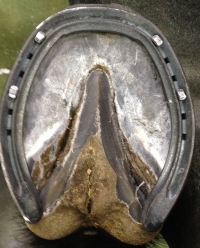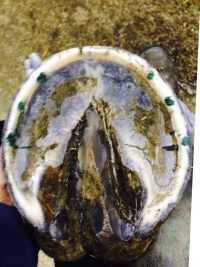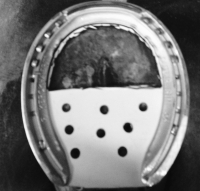In last month’s column, I discussed size and type of nail. After deciding what nail is needed, the next step is to decide how many nails to use, and where they should go.
Several factors go into deciding how many nails to use. Size of the hoof, shoe type, whether pads are used or not, and traction of the shoe all play a part in this decision. For example, a large, flat-footed horse with full pads and borium will require an eight-nail pattern (it is rare to use more than eight).
A small hind shoe with toe clips can often get by easily with four nails (Fig. 1). In farrier circles, a clip is considered equal to two nails in terms of resisting shear force. If you have a small, toe-clipped hind on a horse, with good quality hoof walls, there is no reason to add more nails and put more holes into that hoof wall.
 (Photos by the author) Fig. 1: The author asserts that a small hind shoe with toe clips can be securely held to the hoof with just four nails.
(Photos by the author) Fig. 1: The author asserts that a small hind shoe with toe clips can be securely held to the hoof with just four nails.
Traction is another factor in deciding how many nails to use. Aluminum shoes are "stickier” than steel when hitting a racetrack. Any added traction increases shear force on the nails. This requires bigger nails, more of them, or possibly both. Aluminum shoes typically expand and contract at the heels more than steel shoes do. This also adds stress to those nails. As far as pads go many are intended to create cushion, which, means movement and that movement is a nailing consideration.
 Fig. 2: The green marks show ideal nail placement in a normal hoof, starting just behind the toe bend and ending at the widest part of the hoof.
Fig. 2: The green marks show ideal nail placement in a normal hoof, starting just behind the toe bend and ending at the widest part of the hoof.
Where to put the nails is possibly the most important aspect of the nailing process. Fig. 2 shows ideal nail placement of a normal hoof. A good nail pattern will start just behind the toe bend and end at the widest part of that hoof. Any nails driven behind the widest part of the hoof compromise the natural heel expansion that happens with every stride. In the case of the heel bruises or contracted heels, I would keep my nails even more toward the toe than normal (Fig. 3).
Certainly “ideal” is not always achievable. Hoof walls get beaten up for many reasons. The biggest is when they jerk off a shoe and some hoof wall goes with it. Manufactured horseshoes are punched with nail holes much farther back into the heel area than an ideal nail pattern. The last two nail holes on the branch of a shoe are usually beyond the widest part of the hoof and are there to give the farrier options in a less-than-ideal situation. I never use that last nail hole because it is just too close to the heels.
 Fig. 3: If heels are bruised or contracted, nails should be kept toward the toe.
Fig. 3: If heels are bruised or contracted, nails should be kept toward the toe.
You will find some variance among different shoe types and manufacturer in nail hole patterns. I believe those last four nail holes in some shoes (two in each side closest to the heels) should not be there. My thinking is that if you are working on a hoof which is that much compromised, then one should be skilled enough to make nail holes wherever they are needed. Nailing into the center of the toe is also unusual. My feeling is if a nail is needed there to keep a shoe from sliding back, a toe clip would be a better option anyway. Plastic shoes are one situation which requires a toe nail justifiably because a plastic shoe isn’t rigid enough to hold its shape without one.
Whether you are tacking on a shoe or shoeing your own horses, selecting and placing the nails properly is important to the functionality of that work. There is much more to it than just keeping the shoe on the hoof.
It is only when the hoof and shoe come together within the confines of form and function that one can truly say, “I nailed it.”
Veteran Standardbred farrier Steve Stanley of Lexington, Ky., authors a monthly column for Hoof Beats, the official harness racing publication of the U.S. Trotting Association. The American Farriers Journal Editorial Advisory Board member offers plenty of practical advice that will be of special interest regardless of the type of horses that you work with. Click here to read more from Steve Stanley's Hoof Beats series.








Post a comment
Report Abusive Comment